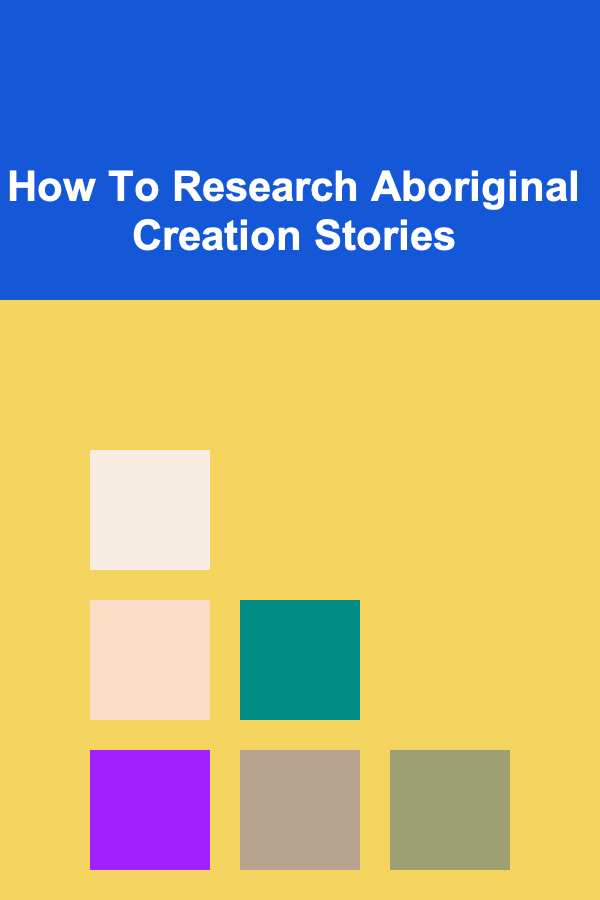
How To Research Aboriginal Creation Stories
ebook include PDF & Audio bundle (Micro Guide)
$12.99$11.99
Limited Time Offer! Order within the next:

Aboriginal creation stories are an integral part of the cultural heritage and spiritual identity of Indigenous peoples in Australia. These stories, which explain the origins of the world, human beings, animals, and the natural landscape, offer profound insights into the spiritual beliefs, practices, and worldview of Aboriginal communities. Researching Aboriginal creation stories requires a respectful approach, as these stories are sacred, passed down through generations by Elders, and often tied to the cultural and land-based knowledge of the community.
In this article, we will explore the steps and methods to undertake a thorough and respectful investigation of Aboriginal creation stories, while also examining the significance of these stories in both historical and contemporary contexts.
Understanding Aboriginal Creation Stories
Aboriginal creation stories, also known as Dreaming stories or Dreamtime myths, are an essential aspect of Aboriginal cosmology and cultural life. These stories explain the origins of the world, the formation of the land, the creation of animals, plants, and humans, and the spiritual connections between all beings. The Dreamtime is considered the time when the world was created, and it is often represented through mythological beings such as ancestral spirits, heroes, and tricksters who shaped the world through their actions.
These stories are typically told through oral traditions, rituals, songs, dances, and art, and vary across different Aboriginal groups. While they share common themes---such as the connection to the land, animals, and ancestors---they are also distinct in how they are told and the specific elements that are emphasized.
For example, the Rainbow Serpent is a recurring figure in many Aboriginal creation stories, symbolizing the forces of life and death, and representing both the creation of the land and the spiritual power that sustains life. Other stories focus on the creation of specific landmarks, animals, or human tribes, which are tied to the geographical location and traditions of particular communities.
Key Themes in Aboriginal Creation Stories
- Creation of the Land: Many stories focus on how the physical landscape was shaped by spiritual beings, who created rivers, mountains, deserts, and forests.
- Ancestral Beings: The Dreaming often features powerful ancestral beings who created the world and its natural elements, providing the framework for how people interact with the environment.
- The Cycle of Life: Aboriginal creation stories emphasize the cyclical nature of life, where death, rebirth, and renewal are seen as part of a natural order.
- Connection to the Land: The Dreaming stories highlight the intimate relationship between Aboriginal people and the land, with the land itself considered to be both a physical and spiritual entity.
Why Research Aboriginal Creation Stories?
Researching Aboriginal creation stories is an essential process for several reasons. It allows for a deeper understanding of Aboriginal culture, spirituality, and history. Creation stories provide insight into the worldview of Aboriginal peoples and their relationship with the land, as well as their social structures, customs, and rituals.
Additionally, these stories help to preserve Indigenous languages, many of which are at risk of extinction. By recording and researching these stories, scholars contribute to the protection of Indigenous cultures and heritage, supporting the broader effort to recognize and respect Aboriginal peoples' rights to their cultural knowledge.
Furthermore, researching Aboriginal creation stories helps challenge stereotypes and misconceptions about Indigenous cultures. These stories offer alternative ways of understanding the world, which can be valuable in contemporary discussions about ecology, sustainability, and social justice.
Approaching Research with Respect
Aboriginal creation stories are sacred and often considered private knowledge that should only be shared with specific individuals, such as initiated members of the community or Elders. When researching these stories, it is vital to approach the process with sensitivity, respect, and a clear understanding of the ethical guidelines that govern the sharing of Indigenous knowledge.
In many Aboriginal cultures, there are strict protocols regarding who can share particular aspects of creation stories. Researchers must be aware of these protocols and seek permission from the appropriate community members before accessing or recording these stories. It is also important to acknowledge the role of Aboriginal Elders and knowledge keepers in safeguarding the stories, and to involve them in the research process.
In the past, much Aboriginal knowledge was exploited or appropriated without the consent of the community. Today, ethical research practices stress the importance of obtaining informed consent, ensuring that Aboriginal communities have control over their cultural and spiritual knowledge.
Ethical Considerations
- Permission: Seek permission from the relevant community members or Elders to access and research creation stories.
- Respect for Traditions: Understand that creation stories are part of a living culture, and they may not be shared in the same way as academic knowledge.
- Cultural Sensitivity: Be aware of the cultural significance of the stories, and recognize the importance of not misrepresenting or distorting Aboriginal beliefs.
- Collaboration: Collaborate with Aboriginal communities to ensure that the research benefits the community and respects their values.
Sources of Information
When researching Aboriginal creation stories, a variety of sources should be considered, ranging from written texts to oral traditions and visual representations. Here are some key sources of information:
4.1. Oral Traditions
Oral storytelling is the primary method through which Aboriginal creation stories are passed down. Elders and other community members are the custodians of these stories, and their knowledge is crucial to the research process. Listening to and recording oral accounts from Aboriginal people is an important way to gather information, though it must be done with consent and sensitivity.
4.2. Written Accounts and Ethnographies
In addition to oral traditions, written records of Aboriginal creation stories have been made over the years by anthropologists, historians, and Indigenous authors. These texts may include ethnographies, collections of myths, or works of literature that reflect Aboriginal perspectives on the Dreamtime and the land.
Notable examples include:
- "The Dreaming" by A. P. Elkin: This book explores Aboriginal beliefs about the Dreamtime and provides a collection of creation stories from various communities.
- "Myths and Legends of the Australian Aborigines" by W. E. Roth: A compilation of Aboriginal myths, including creation stories from different Indigenous groups.
- Indigenous-authored works: Many contemporary Aboriginal authors, such as Oodgeroo Noonuccal and Kim Scott, incorporate creation stories and Dreaming themes in their writing, providing a modern perspective on these ancient narratives.
4.3. Art and Visual Representation
Aboriginal art, particularly dot paintings and rock art, often depicts creation stories and the Dreamtime. These visual representations can provide valuable insights into the symbolism and themes of creation narratives. Researching Aboriginal art through museum collections, galleries, and exhibitions can offer a complementary understanding of the stories.
For instance, the rock art of Kakadu National Park in the Northern Territory depicts ancestral beings and Dreaming stories that are integral to the cultural identity of local Aboriginal groups.
4.4. Cultural Centers and Museums
Many Aboriginal communities have cultural centers, museums, and archives that house collections of creation stories, artworks, and other cultural materials. These institutions can serve as valuable resources for research and often provide opportunities for collaboration with Indigenous communities.
Interviewing Aboriginal Knowledge Keepers
When conducting research on Aboriginal creation stories, interviews with knowledge keepers, community Elders, and other experts are invaluable. These individuals possess a deep understanding of the stories and the context in which they are told.
It is crucial to approach interviews with respect, understanding that the knowledge shared is often considered sacred. Researchers should ask open-ended questions, avoid making assumptions, and be prepared for the fact that some stories may not be shared or may be shared only in certain contexts.
Conducting Ethical Interviews
- Establish Trust: Build a rapport with the community and ensure that your research goals are aligned with their interests.
- Cultural Sensitivity: Be aware of cultural norms and etiquette when interacting with Aboriginal people.
- Transparency: Explain how the information will be used and who will have access to it. This ensures that the community's wishes regarding the sharing of knowledge are respected.
- Confidentiality: Ensure that any sensitive information shared in the course of interviews is handled with care and confidentiality.
The Role of Technology in Research
Advancements in technology have played a significant role in the documentation and preservation of Aboriginal creation stories. Digital platforms, such as websites, podcasts, and video recordings, have provided new opportunities for sharing and preserving these stories for future generations.
Technology has also allowed Aboriginal communities to assert greater control over the sharing of their cultural knowledge. Many communities are now involved in digital storytelling projects, using multimedia to convey their creation stories to a global audience while ensuring that the stories remain protected and respected.
Conclusion
Researching Aboriginal creation stories is a complex and multifaceted process that requires a deep understanding of Aboriginal culture, sensitivity to ethical considerations, and a commitment to respectful collaboration with Indigenous communities. By recognizing the significance of these stories and the cultural protocols that govern their sharing, researchers can contribute to the preservation and understanding of Aboriginal worldviews, traditions, and spiritual beliefs.
Above all, it is essential to approach this research with humility, recognizing that Aboriginal creation stories are not just subjects of academic inquiry, but sacred knowledge that is deeply intertwined with the identities, histories, and lands of Indigenous peoples. By respecting these traditions, researchers can help ensure that Aboriginal creation stories continue to be honored, shared, and understood for generations to come.
Reading More From Our Other Websites
- [Hiking with Kids Tip 101] Top & Kid‑Friendly Hiking Apps Every Family Should Download
- [Home Lighting 101] How to Create Mood Lighting with Dimmers and Smart Controls
- [Tie-Dyeing Tip 101] Eco‑Friendly Tie‑Dye: Sustainable Fibers and Natural Dyes for a Greener Wardrobe
- [Personal Care Tips 101] How to Cope with Anxiety in the Workplace
- [Home Cleaning 101] How to Clean Your Home Before Moving In
- [Home Budget 101] How to Budget for Family Activities Without Overspending
- [Personal Finance Management 101] How to Save Money on Utilities and Lower Your Bills
- [Organization Tip 101] Why A Clean Garage Can Enhance Your Home's Curb Appeal
- [Skydiving Tip 101] Choosing the Right Drop Zone: How to Find the Perfect Skydiving Center for Beginners
- [Metal Stamping Tip 101] The Evolution of Metal Stamping Techniques for Energy‑Efficient Appliances

Building Blocks of Operational Mastery: Essential Skills for the Modern Operations Director
Read More
How to Make a Checklist for Backing Up Your Website Regularly
Read More
How to Create Profitable Advertising Campaigns
Read More
How to Track Utilities Expenses Using Google Sheets
Read More
10 Tips for Scratch-Building Model Cars from Kits
Read More
10 Tips for Budget-Friendly Weekly Meal Planning
Read MoreOther Products

Building Blocks of Operational Mastery: Essential Skills for the Modern Operations Director
Read More
How to Make a Checklist for Backing Up Your Website Regularly
Read More
How to Create Profitable Advertising Campaigns
Read More
How to Track Utilities Expenses Using Google Sheets
Read More
10 Tips for Scratch-Building Model Cars from Kits
Read More